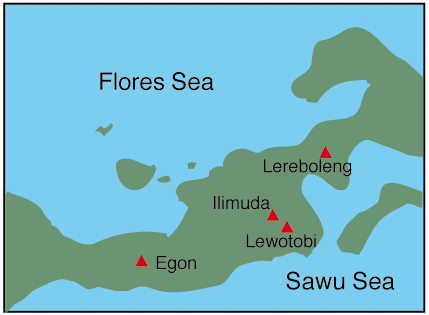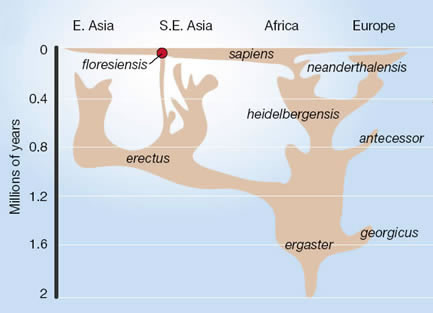When the hobbits lived
*Translation, with all the fault inclused of course, from italian Vittorio Sossi
A new hominid reopen the discussion about the human genealogical tree
29 October 2004
Natures of this week announce the discover on the island of Flores, exotic little island between Java and Timor, belonging to the indonesian archipelago, of an unusual and an extraordinary dwarf hominid, an individual just one meter tall approximately and with a tiny physique incredibly similar to that of the nice hobbits, the deeds of which Tolkien has narrated to us.
update: october 2005
ten small hominids... for now
After the announcement made to March that the man of Flores indeed existed and after the critics and the skepticism that such discovery provoked in some scientists a little too much mistrustful, Natures publish into the number 13 of October 2005, the ulterior evidence of what already asserted and assumed by two palaeoanthropologist of the Australian University Peter Brown and Michael Morwood.
Others nine specimens of small men are brought to light thanks to the sage and meticulous work of the same team of scientists. Even if this time the skeletons of the ancient little men are not completely reassemblable, every hobbit gives its small contribution for a more precise and exhausting reconstruction of its features.
But with this recent recovery, thanks to the presence of the other elements with which they are brought to the surface, it can be asserted with certainty that the hobbits, although theirs reduced grey mass - we are talking about only 380 cc against 1400 cc and 1700 cc for the Neanderthal and the Sapiens - they were able to hunt and they used primitive arms obtained from the working of stones. Manufactures very simple, surely, but undiscussed evidence of their logical-deductive ability. Another very significative datum emerged now is that they knew how to use the fire. The cove of Liang Bua, where they have been identified also this time, has hidden for years, with they, the rests carbonates of animals bones also.
The hazardous hypothesis, of which it was spoken to March already, about third species finds now therefore roots still more credited; much more than the period of permanence of the floresiensis seems to grow longer until approximately 90 mila years ago. The homo floresiensis of Liang Bua is not therefore a copy deformed but an individual, a population, a member of a small, about a meter tall, with a brain sure less developed than that one of our more directed ancestors and their primitive stepbrother neanderthalian man, but absolutely able to survive without too many difficulties and for a long time, thousands of years, on a island that, as far as beautiful and fantastic one, was not sure lacking in dangers and difficulty.
After the clamorous literary and cinematographic success the hobbits continue make us to dream.
 geographic area
geographic area of the discovery
According to that related by Peter Brown and Michael Morwood - anthropologists of the New England University of Armida in Australia and confirmed by the other indonesians authors of the search, led by Thomas Sutikna of the Center of Archaeology of Jakarta, the mythical "small people" really existed, or rather, representatives of its species lived until approximately 18000 years ago on this country already fantastic by itself.
“ The skeleton of Flores „
Here the Varani, or giant dragons of Komodo, and lizards roamed trough together over the dug up tracks equally evocative of giant rats and primitive dwarf elephants, the Stegodon. To onor of the true, and in spite of the diffused scientific misogynism, the found skeleton seems to belong to one female, therefore to one little woman, not more than a meter tall and with one rather small head, approximately a third of the average size of the modern man.
“ a difficult recovery „
The bones: skull, jaw, pelvis and tibia have been dug up in a cove, Liang Bua, with those of one Varanus and the skeleton of one Stegodon. All these rests, at the moment of the discovery, were not still fossilized. The bones were still humid and wettish so that the procedure of recovery and manipulation has been very complicated. Richards Roberts, an another Australian archaeologist angaged in the study, has not hesitated to define their conditions much similar to those of more modern "mashed potatoes" and for this he complimented with Sutikna and the whole indonesian team that had given a demonstration of great ability in handling samples so delicated.
The discovery of the hominid, named Homo Sapiens floresiensis, is a lot important for the palaeoanthropologic studies because it has confirmed the existence of other ramifications, also rather recent, of the human evolutionary tree. The scientists, in fact, know for sure that approximately 1,6 million years ago on the island of Java lived the Homo erectus and that only much later, approximately 45-50 thousands years, the Homo sapiens had put foot in Australia crossing the Line of Wallace, natural barrier that discouraged every attempt of animal and plants migrations.
“ a new collateral branch „
 the Homo genealogical tree revised © Nature.com
the Homo genealogical tree revised © Nature.comBut if on this indonesian island, the Homo floresiensis were effectively present to start from approximately 80 thousands, and until 12 thousands, years ago, like the recent ones fossils testify, then are more and more probable the directed progeny of this population dwarf from the Homo erectus . The geographic isolation, and therefore the genetic one, in which the unusual population was come to find ended for originating one nearly human species that enabled the representatives of the "small people" to survive in this ecological habitat, the island of Flores, until the modern ages - even 12,000 years ago- age in which the Homo sapiens, with its innate passion for the travels, broke off the spell.
